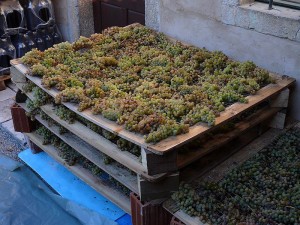
What are the origins of sweet wines? Evolutionary biologists tell us that our distant hominin ancestors came down from the trees already addicted to the sweet taste of ripe fruit. Grapes, having the highest load of sugars of any fruit were thus instantly attractive to our protoselves wherever we found them.
What a thrill when we first learned that those sugars would spontaneously ferment, engendering that marvelous, mood-altering substance alcohol. Hurrah!
Now imagine the disappointment which must have followed when we realized the cost. All that dreamy sweetness that attracted us to grapes in the first place was used up in making ethanol. Boo! Hiss!
My guess is that it was a yearning to have our fructose and our alcohol too drove early experiments aimed at creating stable, palatable sweet wines. Accomplishing this would have involved managing yeasts in a process similar to that by which larger animals were domesticated to serve human convenience. Keeping a herd of goats or sheep for the meat and milk they can provide required pastoral peoples to think in terms of sharing, rather than just extracting. It’s clear that sheep need milk to raise their young, and that since a proportion of these young need to be preserved to breeding age in order to perpetuate the herd all the animals cannot be slaughtered before they’ve had the chance to produced offspring themselves. Once the future of the herd is assured, shepherds can safely take the surplus milk and meat for themselves. Today we call this sustainability.
A yearning to have our fructose and our alcohol too drove early experiments aimed at creating stable, palatable sweet wines.
Early winemakers likely applied essentially the same principle to create sweet, alcoholic beverages. They did this by inventing techniques for generating a surplus of sugars prior to fermentation, an amount over and above what was required to satisfy the voracious appetite of the yeasts.
This strategy could succeed because while fructose and glucose-loving yeasts live and reproduce on sugar, they have a very limited tolerance for alcohol. As hordes of these tiny creatures gorge themselves on sugars in the fermenting tank, alcohol levels rise to concentrations that eventually prove deadly to them. When yeasts die fermentation stops. Whatever sugar has not been converted to alcohol and CO2 remains in the wine – the surplus that provides the sweetness.
Ancient techniques to raise sugars to levels that would provide this surplus involved simple methods of concentration: allowing grapes to hang on the vine beyond normal ripeness, twisting the stems on ripe bunches while still on the vine so the berries dessicate, harvesting at normal ripeness and spreading the grapes out on mats to dry (the passito technique). All are still in use.
After the invention of distillation it became possible to arrest fermentation at any point by the addition of yeast-lethal amounts of neutral grape spirits (very high in alcohol) – standard practice in Port production. Once refrigerated tanks came into use, fermentation could be stopped simply by dropping the temperature.
It all makes one wonder why we exert so much energy debating whether man’s first domestication success involved macro fauna like the dog, the goat, sheep, or even bees when our original conquest may have been over the lowly, unseen and as yet unsuspected . . . yeasts.
Stephen Meuse can be reached at stephenmeuse@icloud.com